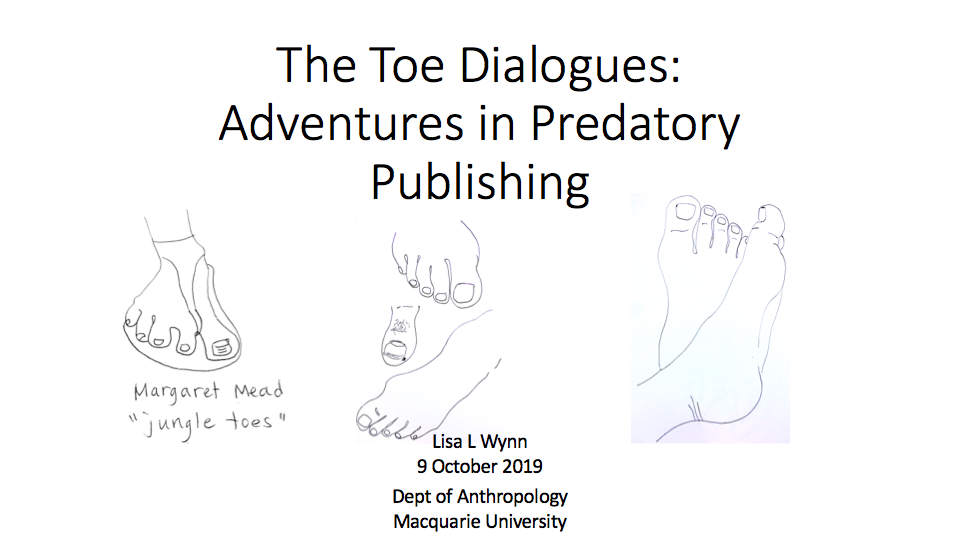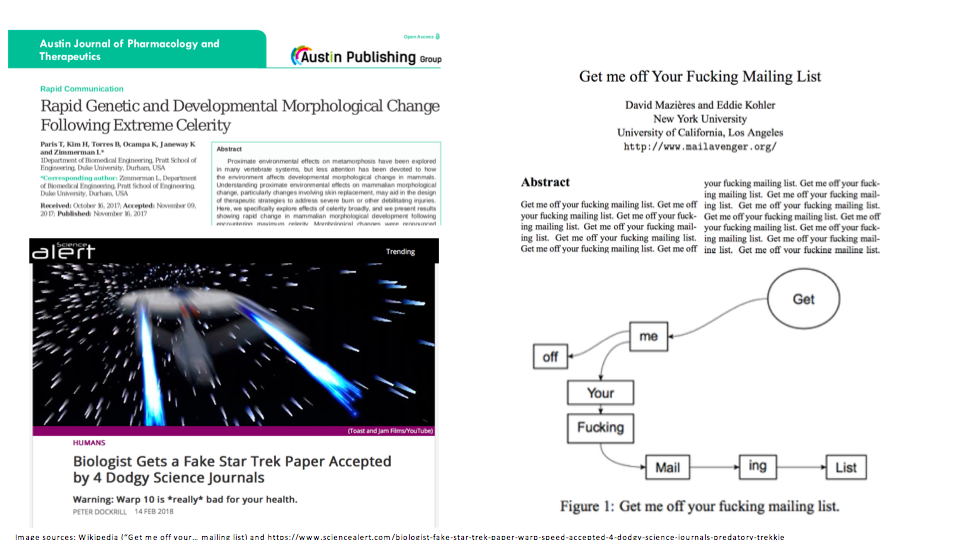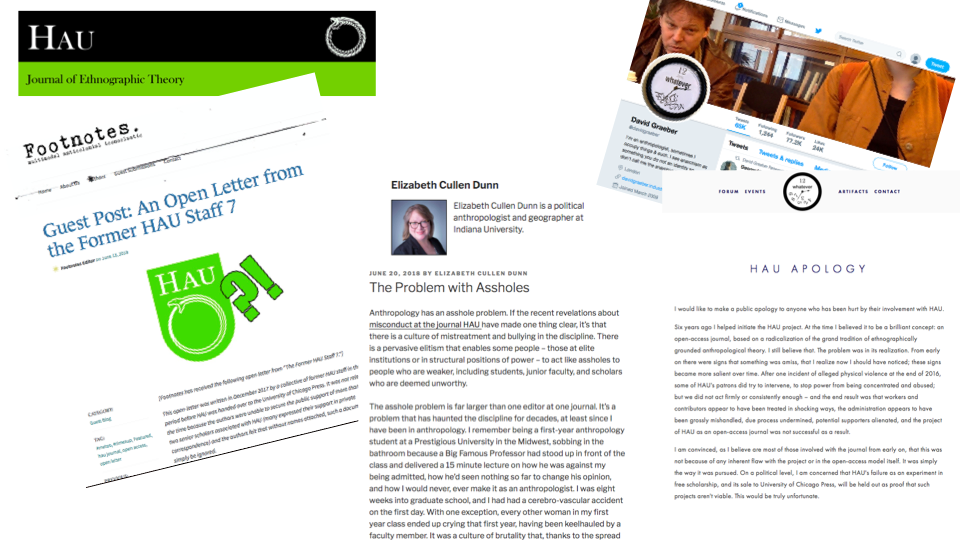Adventures in Predatory Publishing
Published: 24 October 2019
Dr. Lisa Wynn reflects on the open access movement that has spawned hundreds of new journals. These spam academics with invitations to pay to publish and are often “predatory publishers", i.e. open-access journals without proper peer review. A number of academics have tested the boundaries of this new publishing world by submitting, and sometimes publishing, ridiculous articles.These jokes ultimately provoke new questions about the term "predator" and about the terrain of academic publishing.

Drawing by author
In August 2017, I received an e-mail from the “Scientific Journal of Robotics” asking me to contribute an article. As a cultural anthropologist who does not do any research on robotics, naturally I had an idea for something I could submit. I wrote back saying,
“I wonder if you might be interested in a speculative article about robotic feet as a kind of sex aid for people with foot fetishes who do not wish to interact with people who have smelly feet? This isn't something I've personally done research on, but I feel I am highly qualified to write speculatively about the topic of feet including robotic feet.”
The journal editor promptly and enthusiastically replied, stating, “the topic is within the scope of the journal.”
I realized that I had not gone far enough in my original article proposal. I replied, thanking her for kindly overlooking my complete lack of scholarly qualifications to write about robotics, and asked whether poems about sucking on robotic toes might fit within the scope of their journal.
While I was waiting for a reply, I invited my Facebook friends to write poems about robot toes for foot fetishists. As toe haikus and limericks flooded my Facebook page, Jessica replied, “Yes, you can send poems as you mentioned.”
A Google search for the “Scientific Journal of Robotics” returns no results.
There’s a long tradition in academia of journal pranks. Sometimes the publishers have been in on the joke. An early example was “The Unsuccessful Self-Treatment of a Case of ‘Writer’s Block”, published in Applied Behavior Analysis in 1974 by Dennis Upper. The shortest journal article ever published, it consists of a blank page with title and author name.
Another famous case where the journal was not in on the joke was that of Alan Sokal, an NYU physics professor, who decided to prove that the highly regarded cultural studies journal Social Text would publish nonsense as long as it was full of postmodern jargon. His spoof article (“Transgressing the Boundaries: Towards a Transformative Hermeneutics of Quantum Gravity”) that claimed that physical reality was a “social and linguistic construct” was accepted. The day it was published in 1996, Sokal simultaneously published an article in Lingua Franca revealing the hoax.
In the 2000s, the open access movement led to one surprising outcome: new opportunities for journal pranks. The movement emerged out of academics’ frustration over how their work was being exploited by for-profit publishers. In response, new journals like PLoS Medicine emerged, with a new payment model: instead of readers paying to read an article, or libraries paying to subscribe to journals, authors (or their research funders) would pay to have their work published. The PLoS open access model meant more readers, and their journal citation index – and thus their reputation – quickly soared.
Seeing opportunities for profit, less reputable publishing companies like OMICS, Creative Education, SM Online Scientific Resources LLC, and Proskolar Publications sprang up like mushrooms, each publishing an ever-increasing suite of open access journals. They download the names of researchers presenting at academic conferences and then spam them with invitations to publish. Such publishers capitalize on academics’ desperation to get their work into print, but they don’t always provide the peer review and editorial functions of reputable publishers.
Several academics have been delighting in demonstrating that these journals are bogus.
For example, biologist Lewis Zimmerman submitted an article based on a StarTrek: Voyager episode in which the captain of the Voyager and one of her lieutenants break warp speed 10, turn into amphibious frog-fish people, mate and have amphibious babies. Zimmerman listed his institutional affiliation as Starfleet Academy. The paper was published in the American Research Journal of Biosciences (Ugolik 2018).

Photo by author
Australian computer scientist Peter Vamplew, in response to a spam e-mail from the International Journal of Advanced Computer Technology, submitted an “article” consisting of nothing but the phrase, “Get Me Off Your Fucking Mailing List.” The phrase was repeated over and over again in the title, in the text, and in a flowchart diagram. The journal editor declared that the so-called article’s “suitability for the journal was excellent” and asked for $150 to publish it.
So for me the question was not, “How far can I push this?” – Vamplew definitively established that there’s no limit to what some of these journals will publish. For me, the question was, “How much fun can I have?”
Thus, when I got spammed with invitations to publish in bogus journals, I responded to those e-mails – usually on a Friday afternoon just before the workweek was over – proposing outrageous contributions. I proposed articles about “toe fetish erotica for the elderly”, a photo essay about “gynaecologists who use their toes to do gynaecological exams”, and a science fiction story about an evil scientist who meets a race of aliens that look like big toes.
Nearly every journal and conference organiser agreed to publish my toe jokes, for prices that ranged from $30 to $150.
Jeffrey Beall, a librarian at the University of Colorado, coined the term “predatory publishers” to refer to open-access journals that do not engage in genuine academic peer review. For years, Beall maintained a list of over a thousand “predatory publishers” – until January 2017, when he took it down, allegedly in response to legal threats from one of the publishers on his list (Basken 2017; an anonymous blogger has archived this list at https://beallslist.weebly.com).
But as I began to receive proofs of spoof articles accompanied by relentlessly polite (if grammatically incorrect) e-mails from journal editors who were clearly struggling to meet their monthly submission goals, I started to feel guilty. Who was the real predator? Was it the polite editors of these journals, offering me the opportunity to be published at minimal cost and without having to deal with the annoyance of peer review? Or was it me, wasting their time and making fun of them on Facebook?
I started thinking more critically about what really constitutes a predator in academic publishing.
I thought about this when the HAU scandal erupted, revealing how even the most acclaimed journals work by predating on junior scholars and grad students for free labour.

Photo by author
I thought about it when the Guardian published an exposé of the triple-dipping of for-profit publishers like Elsevier: first, they take academics’ research and writing for free. Then they get academics to work for free as peer reviewers. And then they charge our universities and the rest of the world to read all of our freely given work. As the Guardian revealed,
"With total global revenues of more than £19bn, it weighs in somewhere between the recording and the film industries in size, but it is far more profitable. In 2010, Elsevier’s scientific publishing arm reported profits of £724m on just over £2bn in revenue. It was a 36% margin – higher than Apple, Google, or Amazon posted that year."
Given all the kinds of predation that underpin academic publishing, why is it that we only refer to one particular kind of journal as “predatory” publishers? There are many ways that academic publishing is a prestige economy, infused with exploitative hierarchies. The journals that want to charge academics a few hundred dollars to publish joke articles are small fry when compared to some of the other predators with whom we all regularly consort.
Perhaps the reason why these small-fry predators get the disparaging label “predatory” is because they lack the social and cultural capital necessary for truly effective predation.
These journals thus act as scapegoats for academics’ own dissatisfaction with academic publishing. Making fun of them has become a ritual that allows us to mock the publishing terrain and laugh at it, without actually disrupting the powerful players that our careers are dependent on.
References
Ugolik, Kaitlin. 2018. “Fake Paper Inspired by ‘Star Trek: Voyager’ Episode 32, ‘Threshold’ Gets Accepted by Scientific Journal.” Second Nexus, March 20, https://secondnexus.com/science/fake-paper-star-trek-inspired-published/, accessed 25 June 2018.
Basken, Paul. 2017. “Why Beall's List Died — and What It Left Unresolved About Open Access.” The Chronicle of Higher Education, 12 September. Available at http://www.chronicle.com/article/Why-Beall-s-List-Died-/241171.
First published: 24 October 2019
<< Anthropology

